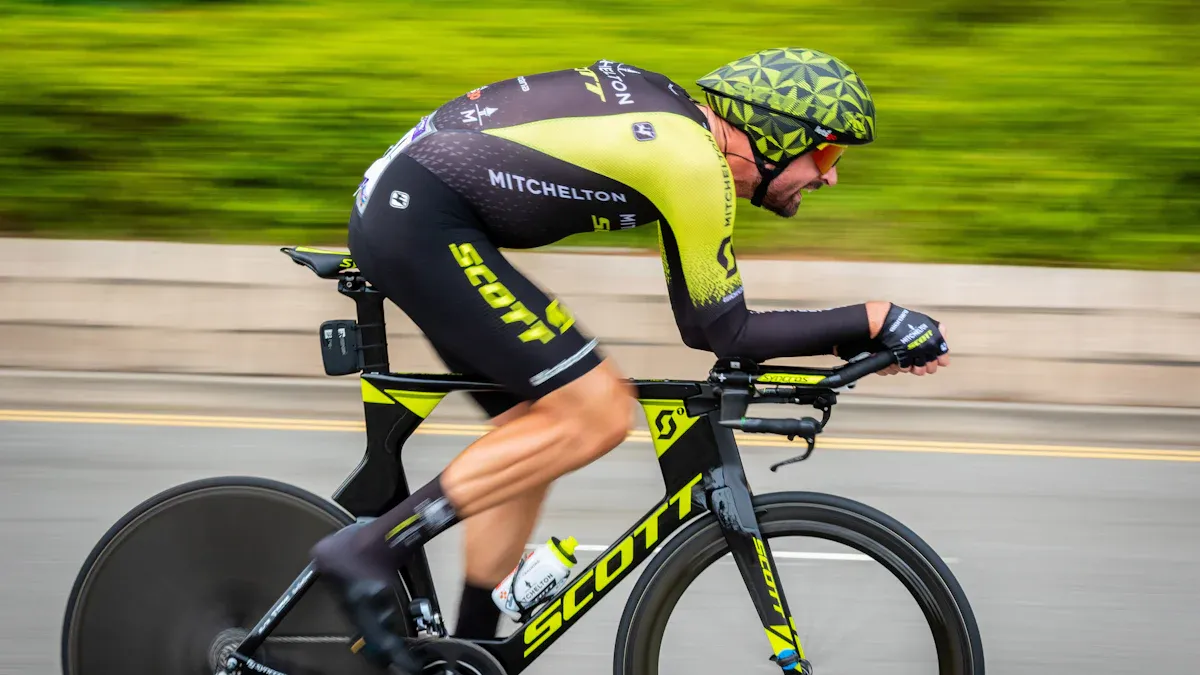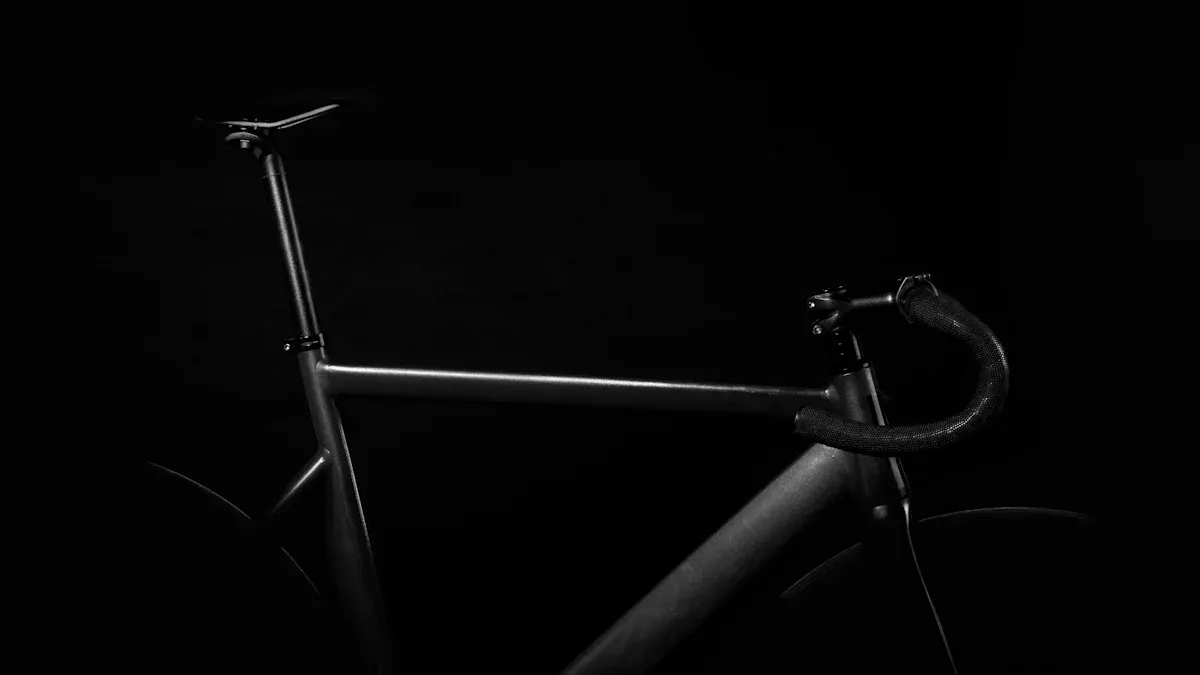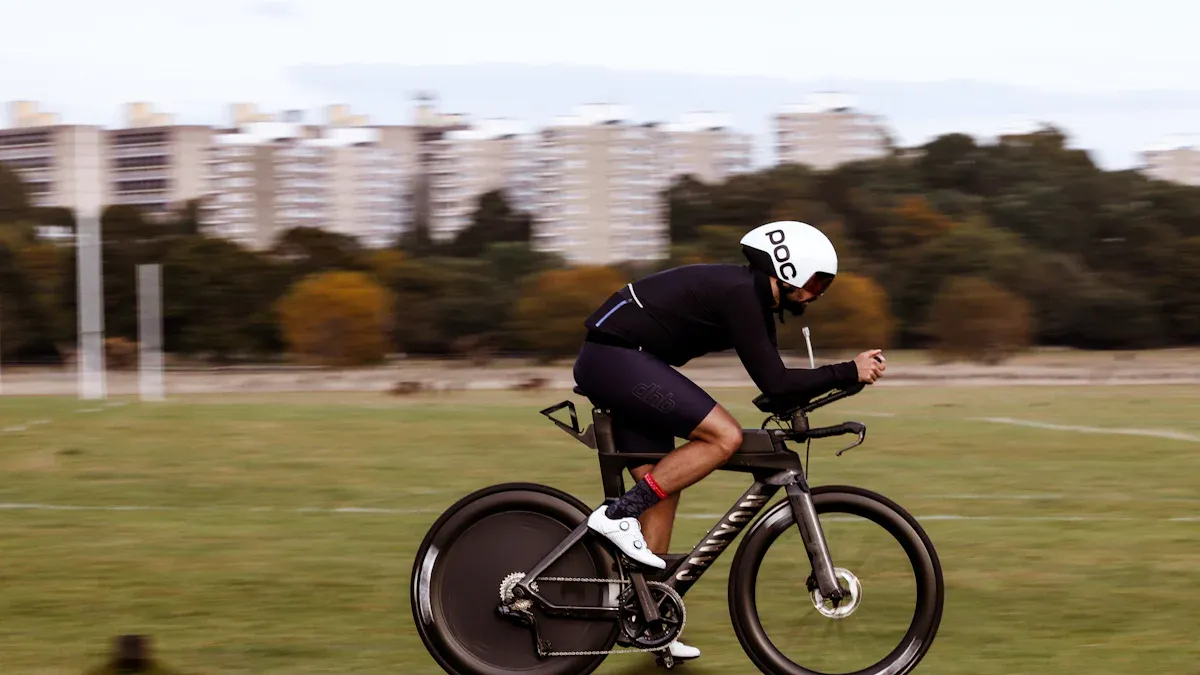
A triathlon bike frame is different from a time trial bike. It has a steeper seat tube angle and special shape. Most triathlon bikes have a seat angle between 78 and 82 degrees. Time trial bikes usually have a lower seat angle. This difference helps you open your hip angle more. It makes running after biking in a triathlon easier. The table below shows how these changes affect your race:
Parameter | Triathlon Bike Frames | Time Trial Bike Frames |
|---|---|---|
Seat Tube Angle | 78–82 degrees (steeper) | 73–74 degrees (shallower) |
Performance | Faster triathlon transitions | Slower run after cycling |
Time trial bike designs must follow strict rules. Triathlon bike frames have more design freedom. These features help you feel better and perform better in a triathlon. As you read, think about your own triathlon goals. Decide what is most important for your next race.
Key Takeaways
Triathlon bike frames have a steeper seat tube angle. This helps open your hips. It also saves your hamstrings for running after biking.
Time trial bikes must follow strict UCI rules. These rules limit design choices. Time trial bikes are very aerodynamic. But they are less comfortable and flexible than triathlon bikes.
Triathlon bikes give you more storage for water and snacks. This helps you stay fueled and hydrated during long races.
The riding position on triathlon bikes focuses on comfort and stability. This is good for long events. Time trial bikes focus on an aggressive, aerodynamic posture for speed.
Pick a triathlon bike for long, solo races. Comfort and running performance matter in these races. Choose a time trial bike for short, flat races. In these races, every second counts.
Frame Geometry

Triathlon Bike Frame Seat Angle
When you look at a triathlon bike frame, you notice the seat tube angle stands out. Most triathlon bikes use a much steeper seat tube angle than other bikes. You often see angles from 78 to even 82 degrees. This steep angle pushes your hips forward on the bike. It changes how your legs move and which muscles you use.
Tip: A steeper seat tube angle helps you save your hamstrings for the run. You use your quadriceps more during the bike leg, which means your legs feel fresher when you start running.
Biomechanical studies show that a steep seat tube angle increases your hip angle. This change lets you open your hips more, which matches the way you run. You also see more activity in your quadriceps, especially the rectus femoris muscle, early in the pedal stroke. This muscle use helps you switch from biking to running with less fatigue. Research even shows that triathletes who ride with a steeper seat tube angle finish their runs faster and feel less tired.
Seat Tube Angle | Hip Angle | Muscle Use | Running Performance |
|---|---|---|---|
81° (Triathlon) | More open | More quadriceps, less hamstring | Faster, less fatigue |
73° (TT/Road) | Less open | More hamstring | Slower, more fatigue |
You also gain comfort on long rides. The forward saddle position and relaxed aero bar setup on a triathlon bike frame help you stay in an aerodynamic position for hours. If you train in this position, you can ride faster and feel better during the run. This optimized geometry is a big reason why triathlon bikes work so well for multisport races.
Time Trial Bike UCI Rules
When you use a time trial bike, you must follow strict UCI rules. These rules shape every part of the frame design. The UCI wants to keep racing fair and focus on the rider, not just the machine.
The seat nose must sit at least 5 cm behind the bottom bracket.
The frame must have a classic triangular shape.
Tube profiles cannot be deeper than three times their width (3:1 ratio).
Handlebar extensions cannot go past 75 cm from the bottom bracket line, except for very tall or short riders.
No extra fairings or special frame modifications are allowed.
Water bottles must stay on the down tube.
These rules limit how creative you can get with your tt bike. You cannot move the saddle as far forward as on a triathlon bike frame. You also cannot use special storage or aerodynamic design tricks that you see on tri bikes. The UCI even checks that all bikes are available for sale and tags each frame to make sure pros do not use special one-off models.
Note: Because of these limits, tt bikes focus on pure aerodynamic efficiency within the rules. You get a bike that slices through the wind, but you may not get the same comfort or flexibility as a triathlon bike.
Triathlon bikes do not have these restrictions. You can use forward saddle positions, deep tube shapes, and built-in storage for food and hydration. This freedom lets you find the best fit for your body and your race. You can adjust your triathlon bike frame to match your needs, whether you want more comfort, better aerodynamics, or easier access to nutrition.
Triathlon bikes often use frame geometry and tube shapes that lower your frontal area and reduce wind drag.
You can ride in a more forward and lower position, which helps you go faster with less effort.
The frame design supports both aerodynamic design and comfort for long distances.
When you choose between a triathlon bike frame and a tt bike, think about your race goals. If you want the best bike for triathlon, you need a frame that lets you ride fast, stay comfortable, and run well after the bike leg. If you race under UCI rules, you must use a tt bike that fits all the regulations, even if it means less flexibility.
Riding Position

Triathlon Comfort and Stability
When you ride a triathlon bike, you feel more comfortable and stable. The way you sit changes how your body feels in long races. Your hips move forward, and you lean over the aero bars. This helps you stay comfy for a long time. It also keeps you steady, even when you get tired.
You change the saddle height and position to fit your body.
Handlebar spot and crank size change how you lean and bend.
Moving the saddle forward makes it easier on your hips.
A good bike fit keeps your muscles balanced and your back safe.
You use different muscles in this position. Your quadriceps do more work. Your hamstrings get to rest. This means you are less tired when you start running after biking. You should train in this position to stop soreness and get better results. Some riders think triathlon bikes are not great for group rides or tricky courses. But they give you the comfort and steadiness you need for multi-sport races.
Tip: Practice riding in your triathlon position often. This helps your body get used to it and makes you less tired during races.
Time Trial Aerodynamics
On a tt bike, you care about speed and cutting wind. The way you sit is more aggressive. You tuck your elbows, drop your head, and keep your shoulders close. This helps you move faster and beat the wind. Tests show that moving your elbows in and hands up can lower drag by 11%. You can save up to 91 seconds in a 40 km tt race.
Aerodynamics are very important in tt races. Your body makes most of the drag, so every change matters. You need strong core muscles to hold this position. Your pelvic floor, diaphragm, and abs work hard to keep you steady. If you are not flexible, you might lift your heels and lose glute power. This can make you slower. If you do not train for this, you make less power than on a road bike.
The tt position needs skill and muscle control.
You must work hard and use good technique to go fast.
Special training helps you stay in position longer and be more aerodynamic.
Note: The best tt riders train their bodies for this tough position. This helps them go faster and get better race results.
Storage and Accessories
Triathlon Storage Solutions
In a triathlon, you must bring water, snacks, and tools. Triathlon bikes have smart ways to hold these things. You can pick storage that fits your race and bike.
Aerobar-mounted bottles go between your arms. This setup fills space and cuts wind drag. You save up to 5 watts over normal bottles. You can drink without moving out of your aero position.
Rear-mounted bottles sit behind your saddle. If you put them low and close, you keep drag down. These help you stay quick while carrying more water.
Saddle bags are small but useful. You use them for spare tubes and tools. Their small size means they do not slow you much.
Frame-integrated hydration systems fit into the bike frame. These are very aerodynamic and can cut drag by 5 to 10 watts. They cost more but keep air moving smoothly and weight balanced.
Some riders use zip-ties to hold a bottle between the aerobars. This easy fix gives you quick access and keeps weight in the middle.
Storage Accessory | Aerodynamics Impact | Weight Distribution / Practical Notes |
|---|---|---|
Between-the-Arms (BTA) Bottle | Most aerodynamic; fills gap between arms, reduces drag | Easy access, keeps you in aero position |
Rear-Mounted Bottles | Can add drag if not placed well; single low bottle is best | Place low and close to saddle for less drag |
Saddle Bags | Minimal aerodynamic impact due to small size | Holds repair tools and spare tubes |
Frame-Integrated Hydration System | Very aerodynamic, reduces drag by 5-10 watts | Higher cost, smooth airflow, efficient weight balance |
These options let you set up your bike for each race. You can mix storage to match your needs and keep your bike fast.
Minimalist Time Trial Bike Setup
Time trial bikes are made for speed and simple setups. You see fewer storage spots on these bikes. UCI rules limit what you can add. Most riders use only what they need for the race.
You often see one bottle on the down tube or between the arms. This keeps the bike light and fast. Riders skip saddle bags and extra storage. They bring just enough to finish the race. The frame hides cables and looks smooth. These things help you move through the wind and focus on speed.
Tip: For time trials, keep your bike simple. Use only what helps you go faster. Extra stuff can slow you down.
Race Suitability
Choosing for Triathlon
You want a bike that fits your triathlon goals. The best bike depends on your race, the course, and what you need. Triathlon bike frames help in long races. They have a steeper seat tube angle. This lets you open your hips more and rest your hamstrings for the run. The frame design helps you switch from biking to running easily. Studies show your position on a triathlon bike changes how you run. You keep your hips open, so you run faster and feel less tired after biking.
Tri bikes work best in races where you cannot draft, like Ironman and 70.3. You ride alone, so aerodynamics are very important. Triathlon bike frames let you stay low and forward. This cuts wind drag and helps you go faster. You also get places to store water and snacks. These features help you stay fueled and hydrated in long races. You can grab bottles and snacks without leaving your aero position. This setup helps you perform well and stay comfy for hours.
Tip: Getting a pro bike fit helps a lot. You ride better when your bike matches your body and race needs.
Tri bikes have some downsides. You lose control on sharp turns or steep hills. The riding position can be hard for new riders. Tri bikes are heavier because of extra storage and aero parts. If your race has lots of hills or allows drafting, you might want a road bike. Road bikes handle better and feel more comfortable in groups and on climbs.
Race Type | Best Bike Choice | Advantages | Disadvantages |
|---|---|---|---|
Ironman/70.3 | Triathlon bike frame | Aerodynamics, speed, transition | Less control, heavier |
Draft-legal Sprint | Road bike | Handling, comfort | Less aero, slower on flats |
Hilly Courses | Road bike | Climbing, cornering | Less aero, slower on flats |
Flat, Long Course | Tri bike | Speed, storage, transition | Less maneuverable |
Think about your skill, race length, and comfort. Tri bikes are best for skilled racers who want speed in long, solo races. New riders or those on tricky courses may like road bikes for their easy handling.
When to Use a Time Trial Bike
Pick a tt bike if you want top speed on flat, fast courses. TT bikes focus on aerodynamics and a low, forward position. You tuck your body to cut through the wind. This helps you in short races where every second matters. Top athletes use tt bikes for short time trials and UCI races.
TT bikes must follow strict rules. You need a classic frame shape and your saddle behind the bottom bracket. You cannot add extra storage or special covers. These rules keep things fair but limit your choices. TT bikes work best on flat roads with few turns. You get the most speed when you stay in your aero position and push hard.
Note: TT bikes are not safe for group rides or draft-legal races. You cannot reach the brakes easily from the aero bars. Quick stops and sharp turns are harder.
TT bikes have some problems. They are not comfy for long rides. The tough position can make your back and neck tired. You carry less water and snacks, which can hurt you in long races. TT bikes are heavier than road bikes, so hills and tricky courses are harder. Use a tt bike when you race alone against the clock on flat roads and want every speed boost.
Use a tt bike for:
UCI time trials
Flat, short races
Solo races where speed is key
Avoid tt bikes for:
Group rides
Draft-legal triathlon races
Hilly or tricky courses
New riders or those who want comfort
Tri bikes and tt bikes both help you go fast and cut wind. You need to pick the right bike for your race, course, and goals. You do best when you train in your race position and choose a bike that fits you. A pro bike fit helps you stay comfy and switch from biking to running, no matter which bike you use.
You can spot big differences between triathlon and time trial bike frames. The table below shows the main ways they are not the same:
Aspect | Time Trial Bikes | Triathlon Bikes |
|---|---|---|
Regulations | ||
Comfort | Less comfy, not easy to adjust | More comfy, fits you better |
Storage | Not much space for storage | Has spots for water and snacks |
Pick a triathlon bike if you want to be comfy, carry things, and switch to running easily.
Choose a time trial bike if you want to go as fast as possible or race in UCI events.
Make sure your bike matches your race and what you need for the best results.
FAQ
What is the main reason to choose a triathlon bike over a time trial bike?
You should pick a triathlon bike if you want more comfort and better running performance after cycling. The frame helps you save energy for the run. You also get more storage for food and water.
Can you use a time trial bike in a triathlon race?
You can use a time trial bike in many triathlons. However, you may feel less comfortable on long courses. You also get less storage for nutrition. Some races have rules, so check before you race.
Why do triathlon bikes have more storage options?
Triathlon races last longer. You need to carry water, snacks, and tools. Triathlon bikes have built-in spots for bottles and food. This helps you stay fueled and hydrated without slowing down.
Are triathlon bikes harder to handle than road bikes?
Yes, triathlon bikes feel less stable on sharp turns or steep hills. The forward position helps with speed but makes handling tricky. You should practice riding your triathlon bike before race day.
Do UCI rules affect which bike you can use?
UCI rules only matter in official time trial races. You must use a bike that fits their rules. In most triathlons, you can use any bike that feels right for you.
See Also
Key Differences Between Track Bike Frames And Others
Why Titanium Bike Frames Stand Out Among All
Comparing Fat And Mountain Bike Frames: Unique Features
